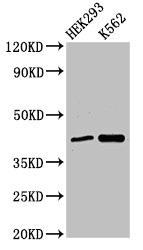Description
| Antibody Name: | FANCF Antibody (PACO52786) |
| Antibody SKU: | PACO52786 |
| Size: | 50ug |
| Host Species: | Rabbit |
| Tested Applications: | ELISA, WB |
| Recommended Dilutions: | ELISA:1:2000-1:10000, WB:1:200-1:2000 |
| Species Reactivity: | Human |
| Immunogen: | Recombinant Human Fanconi anemia group F protein (295-341AA) |
| Form: | Liquid |
| Storage Buffer: | Preservative: 0.03% Proclin 300 Constituents: 50% Glycerol, 0.01M PBS, pH 7.4 |
| Purification Method: | >95%, Protein G purified |
| Clonality: | Polyclonal |
| Isotype: | IgG |
| Conjugate: | Non-conjugated |
 | Western Blot. Positive WB detected in: HEK293 whole cell lysate, K562 whole cell lysate. All lanes: FANCF antibody at 3µg/ml. Secondary. Goat polyclonal to rabbit IgG at 1/50000 dilution. Predicted band size: 43 kDa. Observed band size: 43 kDa. |
| Background: | DNA repair protein that may operate in a postreplication repair or a cell cycle checkpoint function. May be implicated in interstrand DNA cross-link repair and in the maintenance of normal chromosome stability (By similarity). |
| Synonyms: | Fanconi anemia group F protein (Protein FACF), FANCF |
| UniProt Protein Function: | FANCF: DNA repair protein that may operate in a postreplication repair or a cell cycle checkpoint function. May be implicated in interstrand DNA cross-link repair and in the maintenance of normal chromosome stability. Defects in FANCF are the cause of Fanconi anemia complementation group F (FANCF). A disorder affecting all bone marrow elements and resulting in anemia, leukopenia and thrombopenia. It is associated with cardiac, renal and limb malformations, dermal pigmentary changes, and a predisposition to the development of malignancies. At the cellular level it is associated with hypersensitivity to DNA-damaging agents, chromosomal instability (increased chromosome breakage) and defective DNA repair.Protein type: DNA repair, damageChromosomal Location of Human Ortholog: 11p14.3Cellular Component: nucleoplasmMolecular Function: protein bindingDisease: Fanconi Anemia, Complementation Group F; Tracheoesophageal Fistula With Or Without Esophageal Atresia |
| UniProt Protein Details: | |
| NCBI Summary: | The Fanconi anemia complementation group (FANC) currently includes FANCA, FANCB, FANCC, FANCD1 (also called BRCA2), FANCD2, FANCE, FANCF, FANCG, FANCI, FANCJ (also called BRIP1), FANCL, FANCM and FANCN (also called PALB2). The previously defined group FANCH is the same as FANCA. Fanconi anemia is a genetically heterogeneous recessive disorder characterized by cytogenetic instability, hypersensitivity to DNA crosslinking agents, increased chromosomal breakage, and defective DNA repair. The members of the Fanconi anemia complementation group do not share sequence similarity; they are related by their assembly into a common nuclear protein complex. This gene encodes the protein for complementation group F. [provided by RefSeq, Jul 2008] |
| UniProt Code: | Q9NPI8 |
| NCBI GenInfo Identifier: | 12232377 |
| NCBI Gene ID: | 2188 |
| NCBI Accession: | NP_073562.1 |
| UniProt Secondary Accession: | Q9NPI8,Q52LM0 |
| UniProt Related Accession: | Q9NPI8 |
| Molecular Weight: | 42,254 Da |
| NCBI Full Name: | Fanconi anemia group F protein |
| NCBI Synonym Full Names: | Fanconi anemia complementation group F |
| NCBI Official Symbol: | FANCF |
| NCBI Official Synonym Symbols: | FAF |
| NCBI Protein Information: | Fanconi anemia group F protein |
| UniProt Protein Name: | Fanconi anemia group F protein |
| UniProt Synonym Protein Names: | |
| Protein Family: | Fanconi anemia group F protein |
| UniProt Gene Name: | FANCF |
| UniProt Entry Name: |






